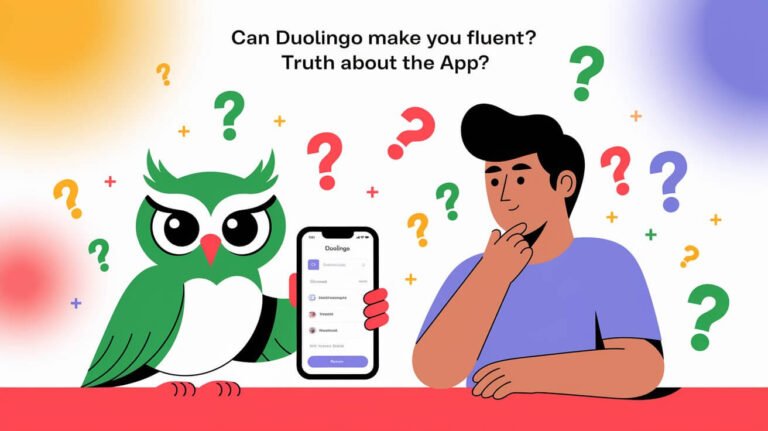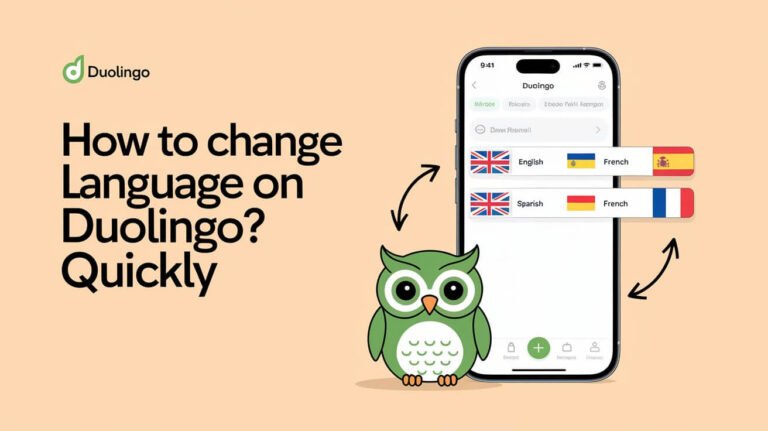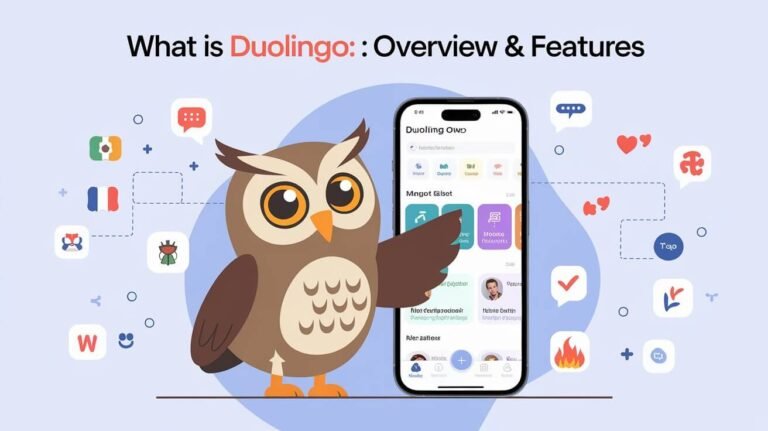
Duolingo, a revolutionary language learning platform, has become a household name. Founded in 2011 by Luis von Ahn and Severin Hacker, it has transformed the way people acquire new languages.
The story of Duolingo’s creation is one of innovation and dedication to making language education accessible and fun. With over 100 million monthly active users, understanding its origins is crucial to appreciating its impact on the world of language learning.
Key Takeaways
- Duolingo was founded in 2011.
- Luis von Ahn and Severin Hacker are the co-founders.
- Duolingo has over 100 million monthly active users.
- The platform is known for making language learning fun and accessible.
- Duolingo’s mission is to revolutionize language education.
Origin of a Language Learning Revolution
The creation of Duolingo was a response to the long-standing issue of expensive and inaccessible language education. For years, language learning had been dominated by costly courses and limited accessibility, making it difficult for many to acquire new languages.
Language Learning Landscape Before Duolingo
Before Duolingo, the traditional methods of language learning were often costly and time-consuming. Language schools and private tutors were the primary means of learning a new language, but these options were not affordable for everyone. Additionally, language learning software and CDs were available but were often expensive and not very engaging.
The table below highlights the key differences between traditional language learning methods and Duolingo’s innovative approach:
| Method | Cost | Accessibility | Engagement |
|---|---|---|---|
| Language Schools | High | Limited | Variable |
| Private Tutors | High | Limited | High |
| Language Learning Software | Medium to High | Moderate | Low |
| Duolingo | Free | High | High |
The Initial Concept for Free Language Education
Duolingo’s founders, Luis von Ahn and Severin Hacker, recognized the need for a free and accessible language learning platform. They aimed to create a platform that would not only be free but also engaging and effective. By leveraging technology and gamification, Duolingo was able to offer a unique solution that has since become the standard for language learning apps.
The initial concept for Duolingo was centered around providing free language education to everyone. This was achieved by creating a platform that was both fun and educational, using gamification elements to keep users engaged.
When Was Duolingo Created: The Founding Timeline
Understanding when Duolingo was created requires looking back at its private beta launch in 2011. This marked the beginning of Duolingo’s journey to becoming a leading language learning platform.
Duolingo’s founding timeline is a story of strategic planning and execution. After its conception, the platform moved into a private beta phase.
The 2011 Private Beta Launch
In November 2011, Duolingo launched its private beta, signaling its entry into the language learning market. This phase was crucial for testing the platform’s features and gathering feedback from early users.
Private beta launch allowed Duolingo to refine its language learning model, focusing on gamification and user engagement.
The 2012 Public Release
Following the success of its private beta, Duolingo publicly released its language learning platform in June 2012. This public release marked a significant milestone, making Duolingo’s innovative approach to language learning accessible to a broader audience.
The public release was a critical step in Duolingo’s growth, attracting more users and setting the stage for its expansion.
First Languages Offered
Initially, Duolingo offered a limited set of languages, focusing on popular choices such as Spanish, French, and English.
The initial language offerings were designed to cater to a broad user base, with the platform gradually expanding to include more languages over time.
| Language | Initial Offering | Notable Features |
|---|---|---|
| Spanish | Yes | Interactive lessons, gamification |
| French | Yes | Speech recognition technology |
| English | Yes | Comprehensive course structure |
The Founders’ Backgrounds
Luis von Ahn and Severin Hacker, the masterminds behind Duolingo, have a fascinating history that contributed to the platform’s revolutionary approach.
Their diverse backgrounds and expertise came together to shape Duolingo into a unique language learning experience.
Luis von Ahn: From reCAPTCHA to Language Learning
Luis von Ahn is known for his work on human computation, particularly with reCAPTCHA, a project that utilized human intelligence to digitize books and improve security.
His experience with reCAPTCHA laid the groundwork for Duolingo’s approach to language learning, leveraging human computation to create an effective and engaging platform.
Luis von Ahn’s vision for Duolingo was to make language learning not only accessible but also enjoyable, using gamification elements and interactive exercises.
Severin Hacker: Technical Expertise and Vision
Severin Hacker, as the CTO and co-founder, brought the necessary technical expertise to develop Duolingo’s early features and functionality.
His technical vision, combined with Luis von Ahn’s background in human computation, enabled Duolingo to innovate in the language learning space.
| Founder | Contribution | Background |
|---|---|---|
| Luis von Ahn | Human Computation, reCAPTCHA | Computer Science, reCAPTCHA co-founder |
| Severin Hacker | Technical Expertise, Platform Development | Computer Science, Technical Visionary |
Early Development Phases
The origins of Duolingo are closely linked with the research and development capabilities of Carnegie Mellon University. This connection played a crucial role in shaping the platform’s early development.
The Carnegie Mellon University Connection
Duolingo was developed with a strong connection to Carnegie Mellon University, where its founders, Luis von Ahn and Severin Hacker, were based. The university’s resources and the founders’ academic background significantly influenced Duolingo’s development. The academic environment fostered innovation and provided the necessary support for the project.
Key benefits of the Carnegie Mellon University connection included:
- Access to cutting-edge research and technology
- Collaboration with academic experts
- A stimulating environment that encouraged innovation
Crowdsourced Translation Model
One of the innovative approaches Duolingo adopted during its early development was the crowdsourced translation model. This model allowed Duolingo to offer its services for free while providing a valuable resource for translation. The crowdsourced approach enabled the platform to rapidly expand its language offerings.
| Feature | Description | Benefit |
|---|---|---|
| Crowdsourced Translation | Users contribute to translating content | Free language learning services |
| Community Engagement | Users participate in the translation process | Increased user engagement |
| Rapid Expansion | Quick addition of new languages | Broad language offering |
Duolingo’s Original Platform Design
The success of Duolingo can be attributed to its pioneering platform design, which leveraged gamification to make language learning an engaging experience. Duolingo’s incorporation of game elements and skill trees transformed the traditional language learning landscape.
Game Elements in Language Learning
Duolingo’s use of game elements, such as points, badges, and leaderboards, encouraged user engagement and motivation. These elements were carefully integrated to make the learning process enjoyable and competitive.
The incorporation of game elements was not arbitrary; it was based on a deep understanding of what motivates learners. By making the process fun, Duolingo managed to keep users engaged for longer periods.
Science Behind Skill Trees
The skill tree system provided a structured yet flexible approach to learning, allowing users to progress at their own pace. This system was based on a well-researched understanding of language acquisition and educational psychology.
Skill trees were designed to offer a clear path forward, with each skill building upon the previous one. This approach helped in reinforcing previously learned material and in gradually introducing new concepts.
| Feature | Description | Benefit |
|---|---|---|
| Points System | Users earn points for completing lessons | Encourages engagement |
| Badges | Visual rewards for achieving milestones | Motivates users |
| Skill Trees | Structured progression through language skills | Personalized learning path |
Funding and Growth Milestones
Duolingo’s journey to becoming a leading language learning platform involved significant financial backing and strategic growth milestones. The company’s ability to secure funding and expand its user base was crucial in its rise to prominence.
Early Investor Support
Duolingo received crucial early support from investors who recognized the potential of its innovative approach to language learning. Initial funding rounds helped the company develop its platform and expand its user base. Investors were drawn to Duolingo’s unique model, which combined gamification with effective language instruction.
Major Expansion Years: 2013-2016
Between 2013 and 2016, Duolingo experienced rapid expansion, driven by its growing popularity and strategic investments. During this period, the company enhanced its platform with new features and languages, further solidifying its position in the market. This expansion was supported by significant funding rounds that enabled Duolingo to invest in product development and user acquisition.
The 2021 IPO
A significant milestone in Duolingo’s history was its Initial Public Offering (IPO) in 2021. The IPO marked a major achievement for the company, reflecting its success and potential for continued growth. The public offering provided Duolingo with additional capital to further innovate and expand its offerings, cementing its status as a leader in the language learning space.
Technological Innovations in Duolingo
Duolingo has harnessed the power of technology to create an engaging and personalized learning experience. This technological innovation is evident in several key areas.
Spaced Repetition System
The Spaced Repetition System is a learning technique that involves reviewing material at increasingly longer intervals to help solidify it in the user’s long-term memory. This method has been proven to enhance learning outcomes and reduce the forgetting curve.
By incorporating spaced repetition, Duolingo ensures that users are consistently reviewing and reinforcing their knowledge, leading to better retention and understanding of the material.
Machine Learning Applications
Duolingo also leverages machine learning to personalize the learning experience. By analyzing user behavior and performance, the platform can adapt to individual learning styles and abilities, providing a more tailored experience.
Machine learning algorithms help identify areas where users struggle, allowing Duolingo to offer targeted exercises and feedback to address these weaknesses.
Mobile App Revolution
The rise of mobile devices has significantly impacted how people learn languages, and Duolingo has been at the forefront of this mobile app revolution. The Duolingo app is designed to be highly engaging and accessible, allowing users to learn on-the-go.
With features like bite-sized lessons and gamification, the mobile app makes language learning convenient and enjoyable, contributing to Duolingo’s widespread adoption.
| Technological Innovation | Description | Benefit |
|---|---|---|
| Spaced Repetition System | Reviews material at increasingly longer intervals | Improves retention and reduces forgetting curve |
| Machine Learning | Personalizes learning experience based on user behavior | Adapts to individual learning styles and abilities |
| Mobile App | Offers bite-sized lessons and gamification | Makes language learning convenient and enjoyable |
Duolingo’s Product Expansion
As a pioneer in language learning, Duolingo has broadened its scope beyond its initial language courses to offer a variety of educational products. This expansion has been pivotal in establishing Duolingo as a comprehensive learning platform.
From Language Courses to Duolingo Stories
Duolingo Stories is one of the notable additions to Duolingo’s product lineup. These interactive stories are designed to enhance reading comprehension and vocabulary in a engaging, conversational format. By incorporating narratives that users can read and listen to, Duolingo Stories makes language learning more immersive and enjoyable.
The Duolingo English Test
Duolingo English Test is another significant product that has been introduced as part of Duolingo’s expansion. This test provides an accessible, affordable alternative for individuals looking to demonstrate their English proficiency, particularly for academic or professional purposes. The test is designed to be convenient, with features like remote proctoring, making it a viable option for those who cannot access traditional testing centers.
Duolingo Math and Literacy Projects
Duolingo has also ventured into math and literacy projects, aiming to provide a broader range of educational resources. These initiatives are designed to support learning in areas beyond language, leveraging Duolingo’s gamification techniques to make complex subjects more engaging. The expansion into math and literacy underscores Duolingo’s commitment to enhancing educational outcomes through technology.
| Product/Service | Description | Key Features |
|---|---|---|
| Duolingo Stories | Interactive stories for language learning | Reading comprehension, vocabulary building |
| Duolingo English Test | English proficiency test | Remote proctoring, convenience, affordability |
| Duolingo Math and Literacy Projects | Educational resources for math and literacy | Gamification, interactive learning |
Global Reach and Cultural Impact
As a cultural phenomenon, Duolingo has made language learning accessible and enjoyable for people worldwide. With its user-friendly interface and gamification elements, Duolingo has become an integral part of the daily routines of millions.
User Statistics and Demographics
Duolingo’s global reach is reflected in its impressive user statistics. As of the latest reports, Duolingo has over 300 million active users across the globe, with a significant presence in the United States, Latin America, and Europe. The platform’s user demographics reveal a diverse community, with users spanning various age groups, professions, and educational backgrounds. Duolingo’s user statistics indicate a strong appeal to a younger demographic, with a significant portion of users between the ages of 18 and 35.
Green Owl in Popular Culture
The green owl, Duolingo’s mascot, has become a recognizable figure in popular culture, symbolizing language learning and fun. The owl’s presence extends beyond the app, with appearances in memes, fan art, and even tattoos. The cultural impact of the green owl is a testament to Duolingo’s ability to engage its users and create a sense of community. The mascot has also been used in various marketing campaigns, further cementing its place in the cultural zeitgeist.
Duolingo’s influence on language learning and its cultural significance are undeniable. As the platform continues to evolve and expand its offerings, its impact on popular culture is likely to grow.
Final Thoughts
Duolingo has revolutionized the way people learn languages, making it more accessible and engaging. Its innovative approach has democratized access to language education, allowing people worldwide to learn new languages effectively.
Duolingo’s impact on language learning is undeniable, with its gamification elements and interactive lessons. The platform’s language learning impact is evident in its widespread adoption and user engagement. As a pioneer in education technology, Duolingo continues to shape the future of language learning.
Duolingo legacy is built on its commitment to providing free, high-quality language education. By leveraging technology and innovative learning methods, Duolingo has made language learning a enjoyable experience for millions of users. As the education technology landscape evolves, Duolingo remains at the forefront, driving progress in language learning.
Answered Questions
When was Duolingo created?
Duolingo was founded in 2011 by Luis von Ahn and Severin Hacker.
Who are the founders of Duolingo?
Duolingo was founded by Luis von Ahn and Severin Hacker.
What was the initial concept behind Duolingo?
The initial concept behind Duolingo was to provide free language education by leveraging technology and gamification.
What was the state of language learning before Duolingo?
Before Duolingo, traditional methods of language learning were often costly and limited in accessibility.
When was Duolingo’s private beta launch?
Duolingo’s private beta was launched in 2011.
When was Duolingo publicly released?
Duolingo was publicly released in 2012.
What were the first languages offered by Duolingo?
Initially, Duolingo offered a few languages, which has since expanded to over 40 languages.
What is Luis von Ahn known for before founding Duolingo?
Luis von Ahn is known for developing reCAPTCHA, a system that uses human computation to help digitize books and improve machine learning models.
What role did Carnegie Mellon University play in Duolingo’s development?
Carnegie Mellon University played a significant role in Duolingo’s early development, providing resources and support.
What is the spaced repetition system used by Duolingo?
The spaced repetition system is a learning technique that reviews material at optimal intervals to improve retention.
How has Duolingo impacted language learning?
Duolingo has democratized access to language education, making it possible for people worldwide to learn new languages in an engaging and effective way.
What is the Duolingo English Test?
The Duolingo English Test is an English proficiency test developed by Duolingo, designed to assess a user’s English skills.
What is the significance of Duolingo’s green owl mascot?
The green owl is Duolingo’s mascot and has become a cultural symbol representing language learning and fun.
How many languages does Duolingo offer?
Duolingo offers over 40 languages.
What is Duolingo’s approach to language learning?
Duolingo’s approach to language learning incorporates gamification, spaced repetition, and machine learning to provide an engaging and effective learning experience.






